Scindapsus: description, types, planting and care rules
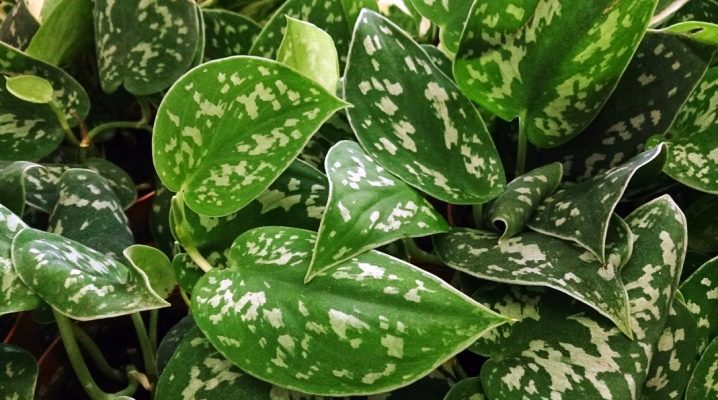
Liana, which migrated to our pots on our windowsills from Africa, Southeast Asia and Polynesia, has a funny name scindapsus. In its homeland, it grows in tropical forests and lives mainly on the ground in the form of a green carpet. And also the scindapsus can climb up the trees. At the same time, flower vines can reach up to 15 meters in length without human intervention.
As a houseplant, scindapsus retains all the same properties, for which flower growers love it. It is suitable so that with its help it was possible not only to decorate a room with a green island, but also to create full-fledged decorative elements in the interior.
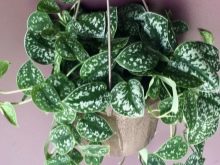
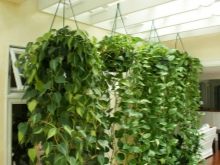
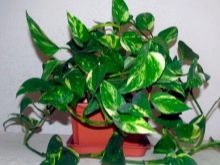
Description
Liana scindapsus is a perennial evergreen with interesting roots. They are interesting because there are three types:
- air, which are used as fasteners to the support;
- air, through which the plant receives the necessary nutrients from the air;
- underground.
Scindapsus belongs to the aroid family and is to a lesser extent, but also poisonous. Scindapsus painted has the highest toxicity level of all species. The juice of this plant can cause not only irritation and itching of the skin and mucous membranes, but also diarrhea. Therefore, it is important to take precautions when working with plants of this genus.
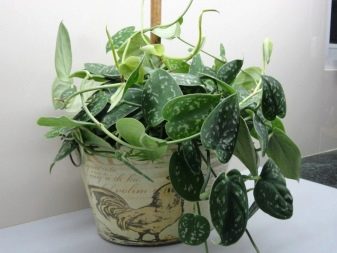
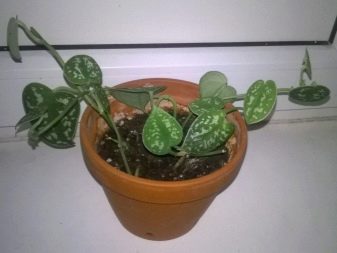
The plant is valued not for its bright flowers, but for how luxuriantly and abundantly it grows and fills all the space allocated to it for growth. This is used by flower growers and designers to create plant panels or other decorative designs in the interior. Common solutions for planting this indoor flower:
- hanging pots;
- vertical stretched supports along the walls to create a green carpet;
- arch;
- curly frames and more.
No matter how the scindapsus is planted, it does an excellent job with its decorative function. Scindapsus leaves of most species and varieties are heart-shaped: more oval at the base and sharply elongated at the ends.
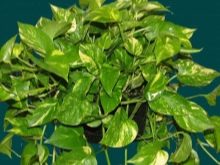
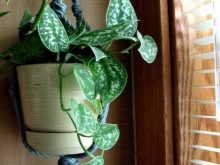
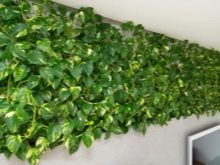
Types and varieties
The types of scindapsus do not have pronounced differences between themselves. The main differences between all varieties are the pattern and color of the leaves. In addition to decorative details, plants can have different lengths of vines and the shape or size of leaves.
In total, there are about 2 dozen different species in nature. But not all are used as indoor plants. Consider only those species that have found their second home in our latitudes.
Most often, golden scindapsus is found in the role of indoor flower. This is due not only to its striking appearance, but also to the relative ease of care. This species got its name from the yellow pattern in the form of stripes or spots on its bright green leaves. The heart-shaped leaves of this species are medium - the length from base to tip can reach from 6 to 12 centimeters.
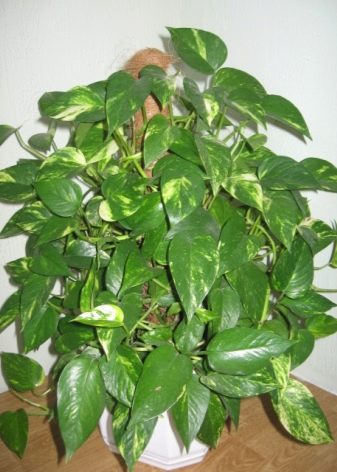

On the basis of this species, various varieties of plants have been bred. The most popular varieties of golden scindapsus are only 4.
- "Golden Queen" has a yellow pattern, sometimes occupying most of the leaf area.

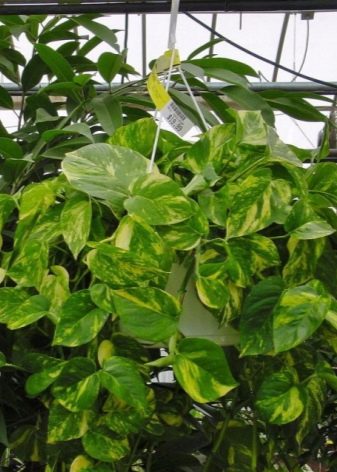
- "The Marble Queen". In some sources, the plant is called "Marble Queen". This variety is vaguely similar to the "Golden Queen", but the pattern on its leaves is more intense.So much so that on some Marble Queen bushes, the leaves look as if it is not a light pattern on dark leaves, but, on the contrary, there are dark blotches on light leaves. The color of the pattern varies from light green to white.
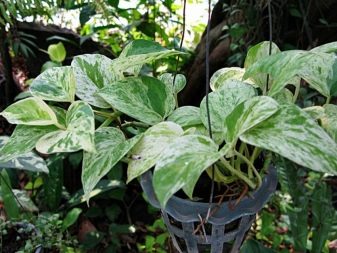

- "Tricolor". This plant has a lighter color in three colors: yellow, green and cream. The pattern on its leaves is more chaotic - instead of pronounced stripes and specks, the leaf is randomly covered with large light spots.
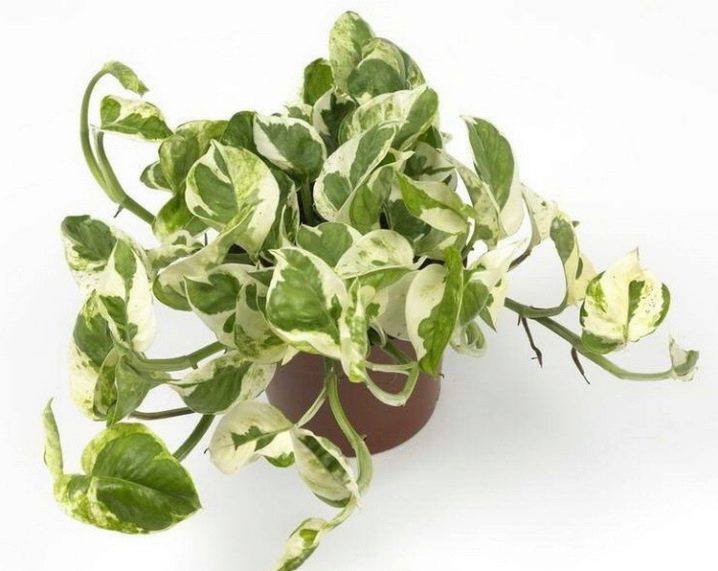
- "N-Joy", aka "N-Joy". This variety is the youngest to date. It was bred by Dutch scientists. The dark green leaves of this species have chaotic light spots that are scattered over the entire surface. The most frequent application of "N-Joy" is landing in a hanging flowerpot.

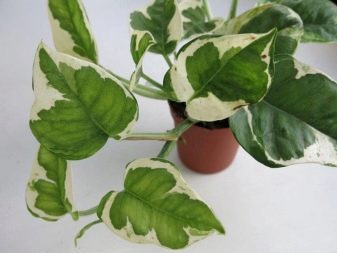
The next type of scindapsus is painted. Another name for this species is pictus. The leaves of these plants look more variegated - the entire leaf area is covered with small contrasting spots, and the same contrasting edging goes along the edge. The color of this species is not the usual glossy, but matte, in gray-green tones. The leaflets are more ovoid and asymmetrical - one half may be much larger than the other.
A plant of this species cannot be called miniature. At home, its vines can grow up to 1 m in length, and in natural conditions - up to 3 m. The superpower of the pictus is increased endurance against pests and possible diseases, which other types of scindapsus cannot boast of.
An adult painted scindapsus can grow vines up to three meters. If such a plant is tied with threads, it can rise with a green carpet to the very ceiling of a standard apartment.
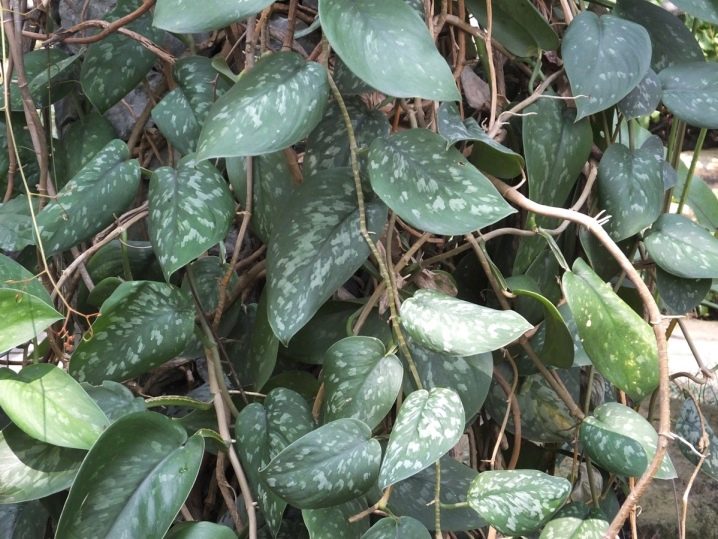
Let's consider the varieties of painted scindapsus in more detail.
- "Exotics". The leaves look like they have a gradient from a silvery green leaf edge to a dark green core. There are no bright and harsh color transitions. The surface of the leaves of this variety appears to be corrugated. To the touch, this corrugation is also felt - thin convex veins go from the core to the edge of the leaves.

- Trebi. This flower has a more contrasting color of leaves with a bright pattern. From a distance, it looks like the back of a lizard. The edges of the leaf are lighter, and the core is always dark.
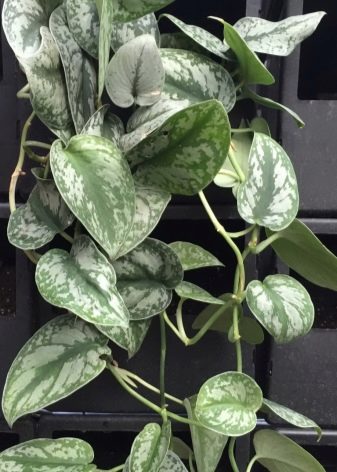
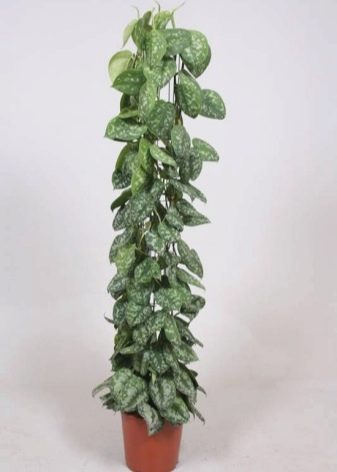
- Argyraeus, which translates from Latin - silver (the name "silver" is found). Silver scindapsus is a miniature liana, and the length of its rounded leaves does not exceed 15 cm in length. The silver scindapsus is named so because of the silver specks on the cold dark green background of the leaves.
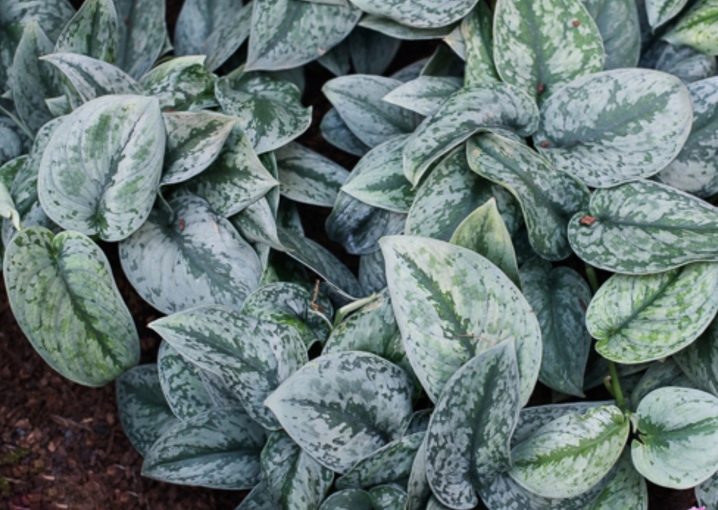
The feathery scindapsus is unique in that it does not have the characteristic feature of all other species of this plant. This is almost the only species that has solid leaves without a color pattern. But this does not prevent him from acting as one of the popular indoor plants. This is because instead of the pattern, the feathery scindapsus has another feature that other species do not have. In partial shade, the color of the leaves of plants of this species is standard dark green, and when the sun hits them, they noticeably brighten and acquire a completely different shade.
This indoor flower grows up to 8 m in length at home. Its vines are very branching. However, the leaves on the vine appear chaotically, with "bald spots": mainly at the bottom and at the top. This spoils the decorative value of the plant.

"Neon" is a favorite of flower growers. It got its name from the bright green neon color that covers its leaves under the influence of the sun.
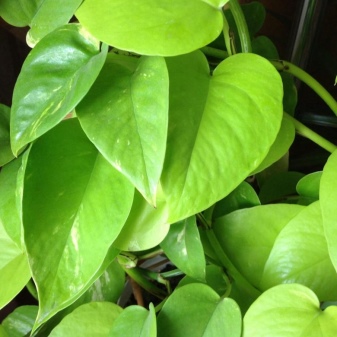
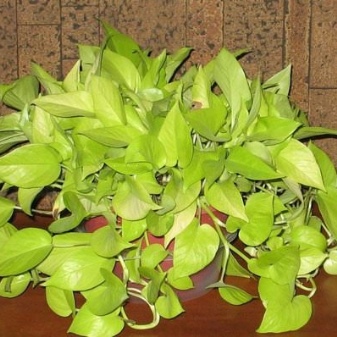
You can find on the Internet the opinion that epipremnum is a Thai clone of scindapsus or a variety of it. Despite their superficial similarities, these are two separate genera of evergreens. They both come from roughly the same region, and both are classified as Aroids.
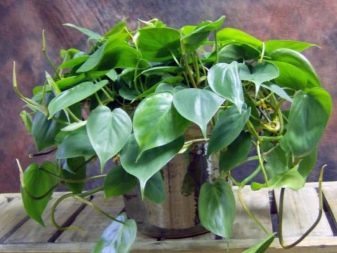
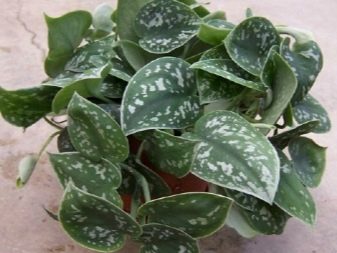
Landing
For scindapsus, it is important to choose the right soil. Dense and oily soil - not immediately, loose and light - what you need. In stores, you can find a wide range of substrates created for deciduous houseplants - all of which will suit Scindapsus. But if possible, you can mix a suitable soil yourself. This will require sand, peat, turf and deciduous humus. All ingredients are taken in the same amount.
Additional looseness is given to the soil by impurities from the drainage material: fine expanded clay, perlite or crushed pine bark. It is optional to add them, but will be useful for improving soil drainage.
A good drainage layer at the bottom of the pot is no longer a recommendation, but a prerequisite. The soil is filled only on a layer of expanded clay, small stones or broken ceramic tiles.
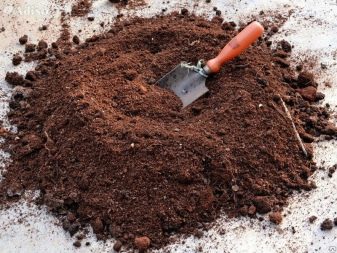
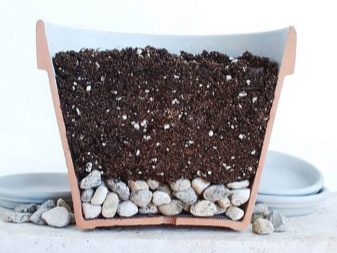
Before planting the plant in a pot, the drainage is covered with a layer of soil. The thickness of this layer is calculated based on the volume of the roots of the plant, so that there is room for another layer of soil on top of the root system. The roots of the scindapsus are laid out on the substrate layer on the drainage, and on top they are covered with the rest of the substrate and carefully tamped.
The plant must be watered immediately after planting. Spring is a good time to change the pot to the Scindapsus.
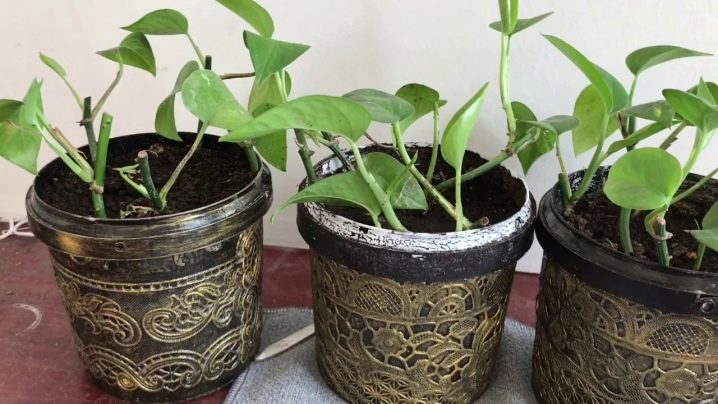
Care
Scindapsus cannot be attributed to unpretentious indoor flowers. It is impossible to simply put it on and not participate in its life, it will be necessary to provide certain conditions.
Lighting
In tropical forests, the plant lives in the shade of trees, so it needs to provide approximately the same conditions in apartments and offices. A place in partial shade or where the light reaches already diffused is suitable for him.
Constant diffused light for half a day is needed only for those varieties that have a bright color of leaves (for example, "Neon"). If the scindapsus is placed in the shade and isolated from light as much as possible, its leaves will lose their brightness and color. This can lead to the flower losing its visual appeal. Therefore, in winter, you need to help the plant "get the norm" in terms of light with the help of a lamp, since the daylight hours become much shorter.
If there are children or animals in the house, the scindapsus should be placed outside their reach. The plant is poisonous.
A good place for a scindapsus pot is north or west windows.
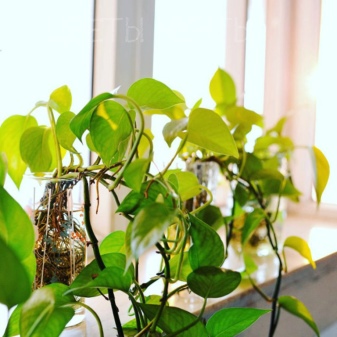
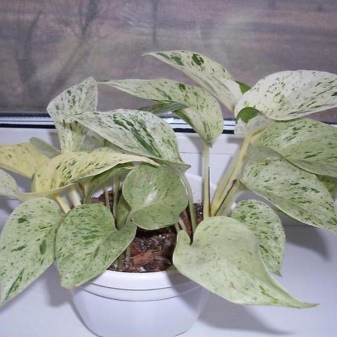
Humidity
The rainforests native to Scindapsus are characterized by high levels of humidity. But you do not need to arrange a swamp in a pot with scindapsus - it will rot. All that is needed is to spray the flower with a spray bottle twice a week. You can shower him three times a month.
Life hack: so that there are no stains and streaks on the leaves, use a spray bottle with a fine spray of a stream of water.
In winter, in order to recreate the tropics of Southeast Asia at home, you need to use a humidifier. So the scindapsus will more easily endure the cold season and the increased dryness of the air in the apartment during the heating season.
If the usual place of a pot with a plant is a window sill above the battery, it must be rearranged for the winter. Hot air from the heater will kill the scindapsus.
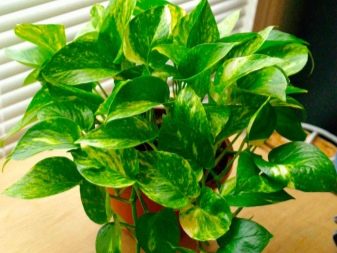
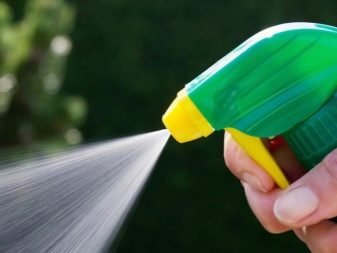
Watering
Scindapsus requires abundant watering only during the period of active growth. In other periods, watering should be moderate.
The plant pot should be on a tray or saucer. After watering, if some of the water forms on the substrate, it must be removed to prevent waterlogging of the scindapsus.
Symptoms that waterlogging did happen is that drops of water form on the back of the leaves of the plant, like condensation. You need to stop watering, and give the flower time to dry for several days.
The soil should be watered no earlier than it dries out by a third after the last watering. In summer, the frequency of watering usually varies from 2 to 4 days, in winter - less often.

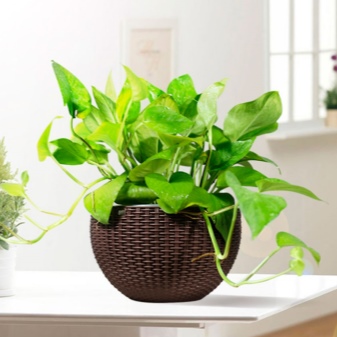
Temperature
From spring to autumn, Scindapsus will feel good at an average temperature of + 20 ° C. In winter, the plant falls into a dormant state, and an average air temperature of + 15 ° C is enough for it.
The restructuring of the temperature regime should be carried out gradually. Scindapsus does not tolerate sudden temperature changes. For the same reason, it must be protected from drafts, which are also destructive for the plant.
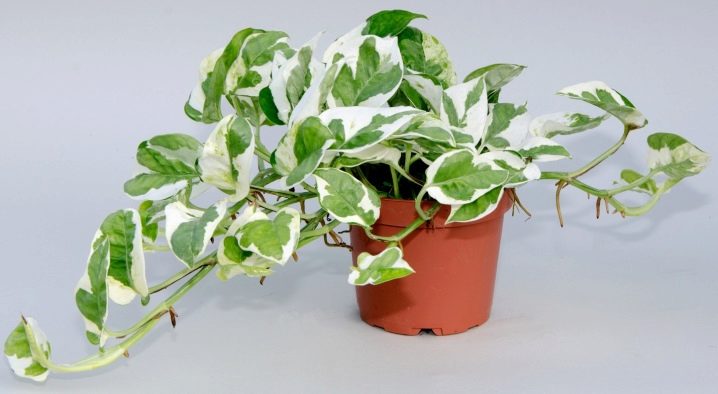
Top dressing
To provide all the necessary substances, the plant is not only periodically transplanted or renewed. To do this, you also need to feed the scindapsus.
In the summer, the plant needs feeding 2 times a month. By autumn, the frequency should be gradually reduced, so that in winter the scindapsus is fed only once a month.
Any mineral fertilizer for decorative deciduous indoor plants is suitable for a flower.
Fertilizer must be applied to the soil after watering to protect the Scindapsus from getting the root system burned.

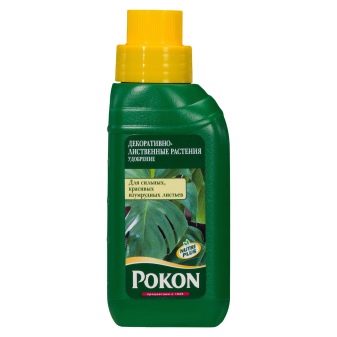
Formation of a beautiful crown
The neat shape of the plant is only the result of working on it. The plant itself grows uncontrollably and chaotically. The key to a beautiful looking scindapus is pinching and pruning. This should be done in the spring, when the plant wakes up after winter and enters a phase of active growth.
Cropping allows you to get the shape you want. The plant needs to cut off all the extra length of the vines with sharp sterile scissors.
Pinching will prevent unwanted vines from growing. To do this, the apical kidney is removed from her. Without it, the vine stops growing in length and begins to grow lateral shoots.
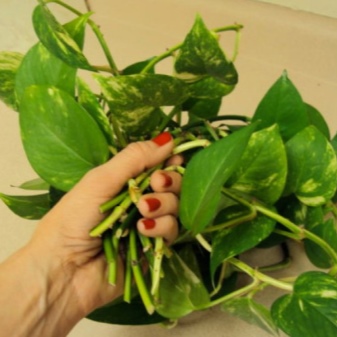
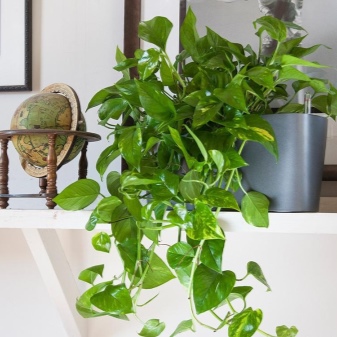
Transfer
Young indoor flower specimens are transplanted every year until they grow to the desired size. An adult scindapsus needs more delicate care. He is shown a transplant only if necessary. An accidentally broken pot can also be an indication for a plant transplant. The reason for the delicacy in the care is fragile vines, which are easy to damage during all transplant operations.
The root system of the scindapsus grows abundantly and fills the entire pot. Therefore, the plant needs a mandatory transplant with a change of pot 1-2 sizes larger. A wide, but shallow pot is best in shape.
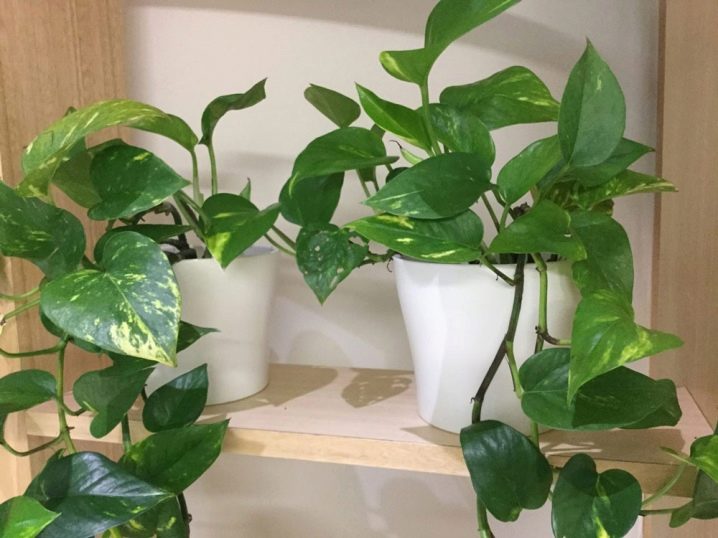
Scindapsus has a pronounced old age. The plant has a lifespan of 4 years. After this period, the flower sheds its leaves. Florists advise not to wait until the plant dies and prepare a replacement for it, grown from its own cuttings.
It is recommended not to replant plants that have long shoots of future vines in the spring. When transplanted, these shoots will break off. Shoots can be cut by yourself. In this case, the transplant can be carried out as usual.
There is a trick that allows you to stimulate the growth of the root system of the scindapsus. To do this, when transplanting, the florist must shorten the existing roots by a third of their length. This manipulation is more convenient and safer for the plant with sharp scissors. Root cuts must be processed with crushed activated carbon.
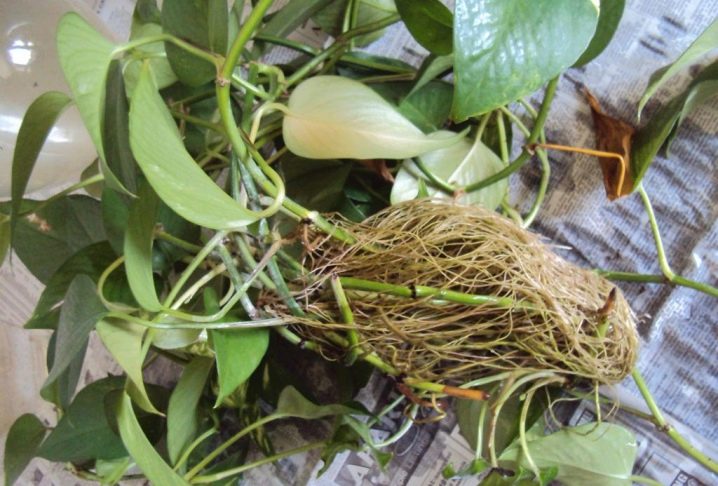
Reproduction methods
Florists propagate scindapsus in two ways.
Cuttings
Cuttings must be cut from the vines so that each has at least 2 internodes - a free stem between two independent deciduous nodules. There should be leaves on the handle for better rooting. The cut is made with a sharp knife at a 45 degree angle.
For rooting, the cutting should be placed in a container with water, to which activated carbon has been added, or directly into a substrate of sand and peat. The future plant needs to be placed in a mini greenhouse to maintain high humidity and elevated temperatures.
Spring or summer is considered a favorable time for propagation by cuttings. But you can perform the procedure in the cold season. Only in this case the cuttings will take longer to take root.
Only a fairly mature plant can be propagated by cuttings. It should have long, strong vines and a good root system. You cannot leave the donor scindapsus naked: only the roots and a stump of the stem.
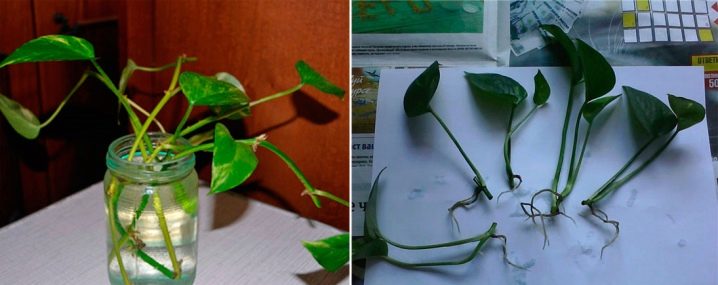
Horizontal layering
This makes it easier to propagate a flower, because fewer body movements are required from the grower.
For the breeding procedure, you will need a parent plant and another pot of soil. Scindapsus liana must be sent to an empty pot, and part of its shoot must be buried in the substrate. It is only necessary to fix the vine so that it does not escape.
After a few weeks, new roots will appear on the stem buried in the ground. When the future scindapsus takes root better (3-4 weeks), it must be separated from the mother plant and further looked after as a separate indoor flower.

Flowering features
Scindapsus practically does not bloom at home, no matter how well it is provided with all the necessary conditions. And at home, he does it every year. Scindapsus has a flower-cob, standard for the aroid family, with a green veil around it. Therefore, flower growers do not consider it a big omission that the plant does not bloom.
There is a possibility that in its entire life as a houseplant, the scindapsus will never acquire flowers. This is normal, and does not mean that you urgently need to sound the alarm and assume that something is wrong with the plant.
In tropical forests, scindapsus not only blooms, but also bears fruit. This can happen as an indoor flower.
It is important to remember that the fruits of scindapsus are very poisonous. If there are children or animals in the apartment, it is better to remove the fruit in order to prevent possible trouble.
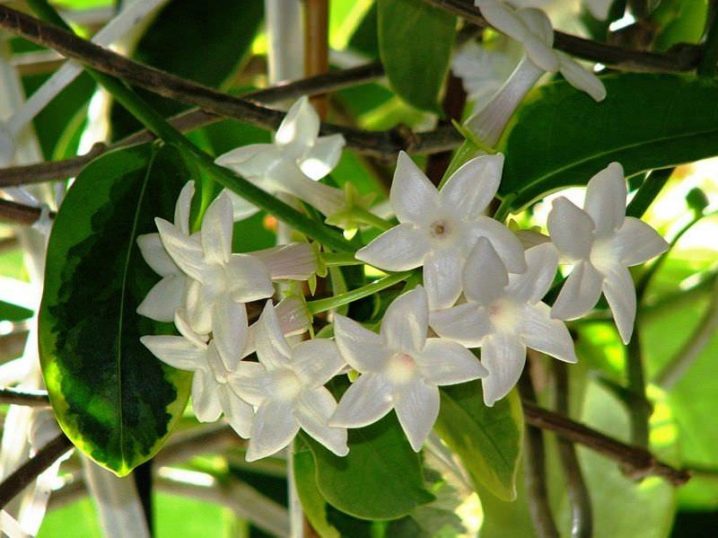
Diseases and pests
Diseases do not threaten scindapsus. It is threatened by improper care and insects.
Symptoms of impaired scindapsus care.
- Leaves turn yellow - lack of nutrients in the soil. The plant needs feeding.
- Stunted growth, or the plant does not grow, in general, is also a lack of substances in the soil, or a small pot. Transplanting into a larger pot and at least partial soil replacement plus top dressing will help.
- Leaves fall - little light or draft. It is necessary to rearrange the pot to a place where there will be no temperature changes and enough diffused light. Penumbra will also work.
- Leaves curl - lack of light. The same thing: you need to rearrange the pot in a lighter place, but not in direct sunlight.
- Brown spots on the leaves Are sunburns. It is necessary to rearrange the pot in partial shade and protect the plant from the sun.
- The scindapsus is pale and inconspicuous, stretched out - lack of light.
- Leaves wither, roots and stem rot - excess watering. You can try to save the plant. This will require a complete transplant into a new dry soil and "amputation" of the parts affected by decay. Before planting in the ground, all sections must be treated with crushed activated or charcoal.
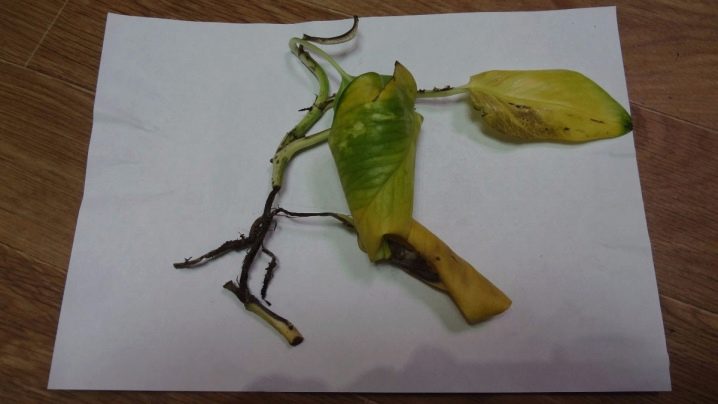
Symptoms of the presence of harmful insects on the scindapsus.
- Small brown spots appeared on the back of the leaf - a scabbard started up. The plant must be treated with Aktellik or another insecticide.
- The streaks on the silvery sheets are thrips. It is also necessary to treat the plant with an insecticide.
- The gray spider web on the plant is a spider mite. To get started, you can treat the plant with soapy water. Dissolve the laundry soap in water until a cloudy solution, but so that it does not look like milk. If the treatment with this solution did not help, then re-treat it with an insecticide.
- Aphids have started up on the leaves - you need to treat the plant with a preparation containing permethrin.

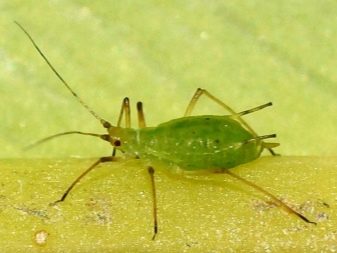
For tips on caring for your scindapsus, see the following video.























The comment was sent successfully.